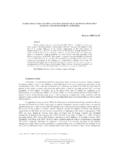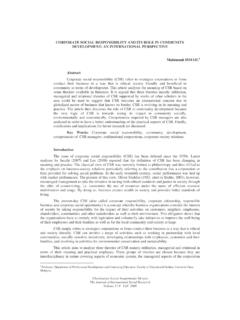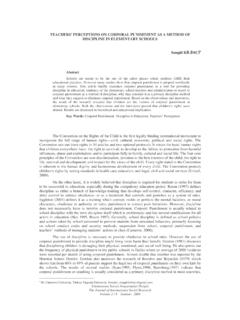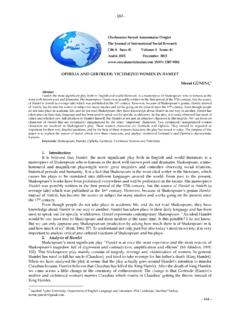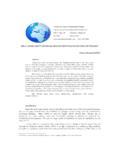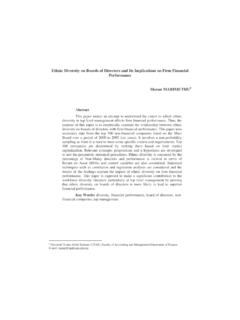Transcription of A SWOT ANALYSIS ON SUSTAINABILITY OF …
1 Uluslararas Sosyal Ara t rmalar Dergisi The Journal of International Social Research Cilt: 6 Say : 28 Volume: 6 Issue: 28 G z 2013 Fall 2013 Issn: 1307-9581 A swot ANALYSIS ON SUSTAINABILITY OF FESTIVALS: THE CASE OF INTERNATIONAL TROIA FESTIVAL Erol DURAN Abstract Events are important motivators of tourism, and figure prominently in the development and marketing plans of most destinations. They are universally important for their social and cultural roles, and increasingly have been promoted and created as tourist attractions. This study is structured into two objectives.
2 The first objective of the study is to identify the current condition of the International Troia Festival (ITF) by definition of problems, managerial challenges, and the roles of stakeholders. This will be achieved through employing observation and interview techniques. The second objective of the study is to identify, the current position of the ITF, including its SUSTAINABILITY and marketplace by employing a swot ANALYSIS . Keywords: Festivals, Festival Tourism, SUSTAINABILITY , Culture, swot ANALYSIS , International Troia Festival. Introduction Festivals are viewed as tools in place marketing and destination image making, and are valued for their ability to animate cities, resorts, and attractions (Andersson and Getz, 2008: 200).
3 The general population of urban centers hosting festivals seldom derives any sustainable employment opportunities from festival tourism (Janniskee and Drews, 1998). Festivals are being more substantial for territorial and regional tourism planning activities. In that respect, the International Troia Festival (ITF) has a high potential of regional and territorial publicity with its historical prosperity from Iliad, with its cultural prosperity from different identities in anakkale, Turkey. anakkale is located in Western Anatolia, and over the years it has become a livable and lively culture and college town with its cultural heritage and activities.
4 The city holds one of the older cultural festivals in Turkey. The event, organized in 1963 firstly by the city municipal authority attracts a significant number of people to its approximately 50 events over a period of 5 days in August every year. The festival is recognized as the symbol of cultural heritage, history, and intercultural communication in anakkale and neighboring cities. The mission of the festival is to enliven and enrich environmental consciousness, cultural awareness, as well as business life in anakkale (G khan, 2011). In case, the ITF is an international cultural festival which is nourished from Iliad, Odyssey, Trojan, Greek, Ottoman, and modern Turkish cultures, is now being organized 50 th time.
5 - 73 - Literature Review Festivals are important topic on the main body of tourism research (Gartner and Holecek, 1983; Getz and Frisby, 1988; Uysal and Gitelson 1994; Gwinner, 1997; Visser, 2005). They generally are, and have been, placed on large scale celebrations to explain, how they may stimulate the economic development of tourist destinations (Walo et al., 1996; Crompton and McKay, 1997; Kim et al., 1998; Thrane, 2002, Saayman and Saayman, 2012), and how they may effect and stimulate socio-cultural structure and prosperity (Rao, 2001; Hall, 2001; Jackson et al.)
6 2005; Varotsis, 2006). In addition, researchers explored motivational factors of visitors and dimensions underlying those factors (Backman et al., 1995; Scheneider and Backman, 1996; Scott, 1996; Crompton and McKay, 1997; Formica and Murrmann, 1998; Lee et al., 2004; Yolal et al., 2009, Hallman and Harms, 2012), as well as their importance in raising destination awareness by conveying its specific identity to maintain competitive advantage (Esman, 1984; Delamere and Hinch, 1994; Besculides et al., 2002), and managerial models in sustaining event lifecycle (Frey, 2000; Varotsis, 2006; Yuan et al.
7 , 2008; Mosely and Mowatt, 2011; van Niekerk and Coetzee, 2011). A number of studies have taken a broader social and cultural identity and prosperity perspective on festivals. Varotsis (2006) applied the notion of a re-interpreting cultural identity with festivals and events. Accordingly, Hall (2001) investigated effects of music and dance festivals on culture and cultural tourism with the sample of Indonesian Island of Bali. Raj (2003) indicated that, the festivals have major impact on the development of cultural tourism to the host communities. The festival organizers are now using the historical and cultural themes to develop the annual events, to attract visitors and to create cultural image in the host cities by holding festivals in the community settings.
8 Therefore, the communities therein, whose members are themselves increasingly on the move, are constantly having to re-interpret their cultural identity in the light of both their immediate, past and projected experiences. Consequently, as researchers (Hall, 2001; Raj, 2003; Inkei, 2005) have contested that, local communities plays vital role with their culture and identity in development of tourism through festivals. Similarly, events and festivals play vital role on cultural identity of local communities, and have a big potential to generate cultural profundity and prosperity when they cater to out-of-region visitors, grants, or sponsorships (Getz, 1997).
9 According to O Sullivan and Jackson (2002), the impact of festival tourism are, however, not always that self-evident. The influx of tourists can result in a change in the community infrastructure to serve the needs of festival visitors, so that as festivals grow and begin to make stronger links outside the locality, local entrepreneurs can become resentful and the economic benefits of the festivals less significant (Visser, 2005: 157). Yolal et al. (2009: 288), identified that, festivals are important on city officials and organizers of the events. They are aware that community cohesion and benefits sought from the festival, as well as the different means for attending the events, are all interconnected.
10 To know the extent of the relationship that exists between those attending events, and their perceptions of the benefits and costs, helps city officials to develop appropriate policies and platforms to further build community cohesion, thereby gaining support from locals for future programs. Tourism and social events provide incentives for locals and businesses (Allen et al., 1993; G rsoy et al., 2004). A number of researchers have emphasized that there is a positive relationship between festival SUSTAINABILITY and community benefits (G rsoy et al.)

